Diesel Service Report, February 6th, 2021
Fairbanks Morse H12-44 SF560
The project is continuing with mechanical repairs on the Diesel engine. John Salvini and Richard Berk have spent many days working on this locomotive. A few months ago, all 12 injection pumps were replaced with known good ones. Shortly after the replacement, a few of the pumps started to become sticky. The #4 pump was now totally stuck and a few more were very tight. Its not known yet what is causing that. The stuck pump was removed and sent back to the supplier for analysis. We need to understand what is causing that problem. One thought is that the low Sulfur fuel is lacking lubricity. We will add a fuel supplement to see if that solves the problem. The fuel tank was totally drained of old fuel before the restoration project was started, so we know the fuel is fresh.
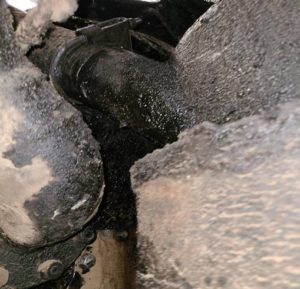 Once the pump issue is solved, work will begin replacing leaking gaskets and seals by the exhaust mufflers. Its hard to describe how dirty that area is.
Once the pump issue is solved, work will begin replacing leaking gaskets and seals by the exhaust mufflers. Its hard to describe how dirty that area is.
The picture (left), shows just a small part of the area above and behind the mufflers, or snubbers as they are called. There is a failed seal on an extension stub shaft coming off the upper crankshaft. Whenever the engine is operated, oil just pours out of that seal area.
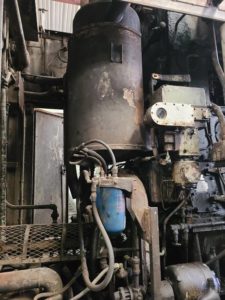
The problem is that the area isn’t accessible unless the snubbers are removed.
The original project cost was estimated at $40,000. As of now, about $20,000 has been raised. We haven’t reached our goal yet but of course the project will continue with the available funds. To donate to the project, please visit the SF560 Collections web site at https://socalrailway.org/collections/santa-fe-railway/560-details/Removing the snubbers will also be a difficult task, but it must be done. This next picture (right) shows one of the two large round snubbers located above a blue fuel filter. Each of them weighs hundreds of lbs.
USAF 1601
The locomotive is now in service, ready for switching duties at the museum. There are a few minor issues to still take care of, but it is now fully functional.
When the locomotive came to the museum, we didn’t know much about it. We knew that two of the traction motors had been electrically isolated and we could see serious damage on the motor commutator copper segments. At the time, we thought that commutator damage was the reason for disconnecting those two drive motors. Little did we know that the commutator problem was just the tip of the iceberg. Now we fully understand that the GE 80 ton center cab switcher locomotives had an Achilles heel that haunted all of them. The real problem with those locomotives as that the ring and pinion gears, also known as hypoid gears, connecting the traction motors to the gear cases, had a high failure rate. Most probably the failures were the result of poor maintenance, improper initial alignment, and being over stressed during operation.
Fortunately, we were able to obtain spare parts and now all four traction motors and gear cases are functional again.
The front and rear foot-boards were removed long ago but we still had the steel brackets. Carl Pickus and Doug Newberry refurbished the brackets, fabricated new wooden foot-boards, mounted them back on the locomotive, and painted both the front and the rear of the locomotive with the original black and yellow scheme. Prior to painting, Jim Gates welded up several extraneous holes in the front plate that were no longer used.
After everything was back together, Tom Platten, Bob Bray, and Tim Johnson, rubbed down a portion of the exterior to start removing paint oxide. It appears that once the oxide is removed, the blue paint will have a nice luster back. There are some rust spots that need to be repaired but overall, the paint is in rather good condition.
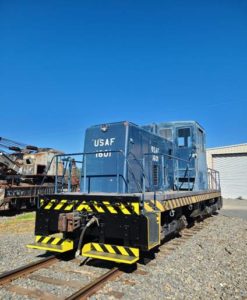 One compressor had a faulty high pressure unloader valve, which Richard and John replaced. That fixed the on-going compressor problem. After that was done, Frank Kunsaitis started the engines, and the compressor regulator was adjusted. However, it was found that the main reservoir safety valve was blowing off at about 130 PSI rather than 150 PSI where is should have been set. It was replaced with a newly calibrated valve. Then the compressor unloader was reset at 140 PSI to unload and 130 PSI to start compressing air again. That system is now functional again.
One compressor had a faulty high pressure unloader valve, which Richard and John replaced. That fixed the on-going compressor problem. After that was done, Frank Kunsaitis started the engines, and the compressor regulator was adjusted. However, it was found that the main reservoir safety valve was blowing off at about 130 PSI rather than 150 PSI where is should have been set. It was replaced with a newly calibrated valve. Then the compressor unloader was reset at 140 PSI to unload and 130 PSI to start compressing air again. That system is now functional again.
Andrew Temoshek has installed a new radio and antenna and Chris Baldwin will program the radio with the appropriate frequencies for museum operation.
The remaining tasks are to change oil in the engines, install new filters, install replacement cab door locks, and replace one Cummins PT fuel pump shut-down solenoid. We expect this locomotive will be the primary engine used for general purpose switching at the museum.
UP942
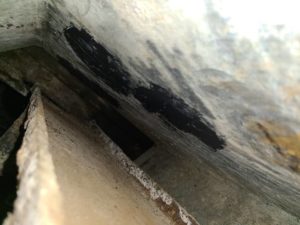 The locomotive came to the museum in the mid 1990s and it was obvious that it had not had radiator cooling water additives in it for many years. There was severe corrosion in many of the lines and especially the water expansion/holding tanks. Finally, the #1 engine water tank sprung leaks in the bottom. John has had good luck repairing those types of rusted metal leaks using JB Weld. He used that material in four areas under the tank and has had water in the tank for a number of days now. It appears the leaks are under control, for now.
The locomotive came to the museum in the mid 1990s and it was obvious that it had not had radiator cooling water additives in it for many years. There was severe corrosion in many of the lines and especially the water expansion/holding tanks. Finally, the #1 engine water tank sprung leaks in the bottom. John has had good luck repairing those types of rusted metal leaks using JB Weld. He used that material in four areas under the tank and has had water in the tank for a number of days now. It appears the leaks are under control, for now.
Unfortunately, removing the tank for a complete repair, is an extremely complicated task. If/when that needs to be done, the locomotive will be out of service for several months. The area that John had to work it was only a few inches high. It was exceedingly difficult to get in there to clean the surfaces and apply the JB Weld. This picture shows two of the dark gray patches. And they are about two feet back in an area where its almost impossible to reach, let alone work or see what is being done. Nice work John.
If the patches hold, the locomotive will be returned to service next week.
50” Sellers Wheel Lathe
Carl Pickus and Doug Newberry have been working almost every day for the past two weeks, fabricating and erecting a steel tube structure over the wheel lathe. Carl purchased 800’ of tubular steel for the frame and will cover it with metal cladding, similar to what is on Carbarn 7.
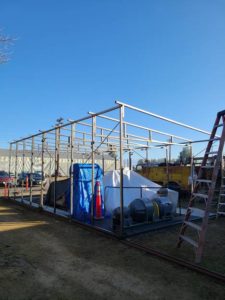 The structure over the lathe is made in two pieces. Each half is on rollers and can roll sideways a number of feet, away from each other. That leaves an area open in the middle to allow a crane or forklift to lower a wheel set down into the lathe for mounting. This picture shows the framework together, but it splits in two and both halves can then be rolled away from each other. Carl has 12 sets of rollers under the frame to allow the pieces to easily roll. A portion of the rail can be extending next to the ladder in the lower right side of the picture.
The structure over the lathe is made in two pieces. Each half is on rollers and can roll sideways a number of feet, away from each other. That leaves an area open in the middle to allow a crane or forklift to lower a wheel set down into the lathe for mounting. This picture shows the framework together, but it splits in two and both halves can then be rolled away from each other. Carl has 12 sets of rollers under the frame to allow the pieces to easily roll. A portion of the rail can be extending next to the ladder in the lower right side of the picture.
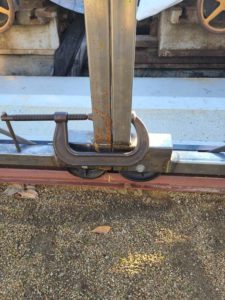 This (right) shows the center posts with wheels under each half and a clamp holding the two halves tightly together. You can also see the V channel rolling track under the wheels. Carl also incorporated a safety flange so that wind will not be able to lift the enclosure off the track.
This (right) shows the center posts with wheels under each half and a clamp holding the two halves tightly together. You can also see the V channel rolling track under the wheels. Carl also incorporated a safety flange so that wind will not be able to lift the enclosure off the track.
When the motor generator set came to the museum, four of the commutator covers were missing. Carl fabricated and installed those missing covers. With those covers on, the complete assembly is essentially weatherproof now.
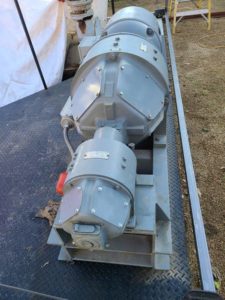 Once Carl and Doug finish with the shelter, 120 VAC single phase and 208 VAC three phase power will be run to the lathe area from the east end of the machine shop. That power will be used for lighting, hand tool outlets, etc. The conduit for that run is already installed. The lathe itself, is powered by 480 VAC three phase, which is already in place and operational.
Once Carl and Doug finish with the shelter, 120 VAC single phase and 208 VAC three phase power will be run to the lathe area from the east end of the machine shop. That power will be used for lighting, hand tool outlets, etc. The conduit for that run is already installed. The lathe itself, is powered by 480 VAC three phase, which is already in place and operational.
When the shelter is completed, the task of cleaning, adjusting, and learning how to use the lathe will begin. This is a very exciting project, and we are all looking forward to having it in operation after over 35 years of sitting in storage.
Dave Althaus
– Link to SF560 Fairbanks Morse H12-44 Restoration Project –

